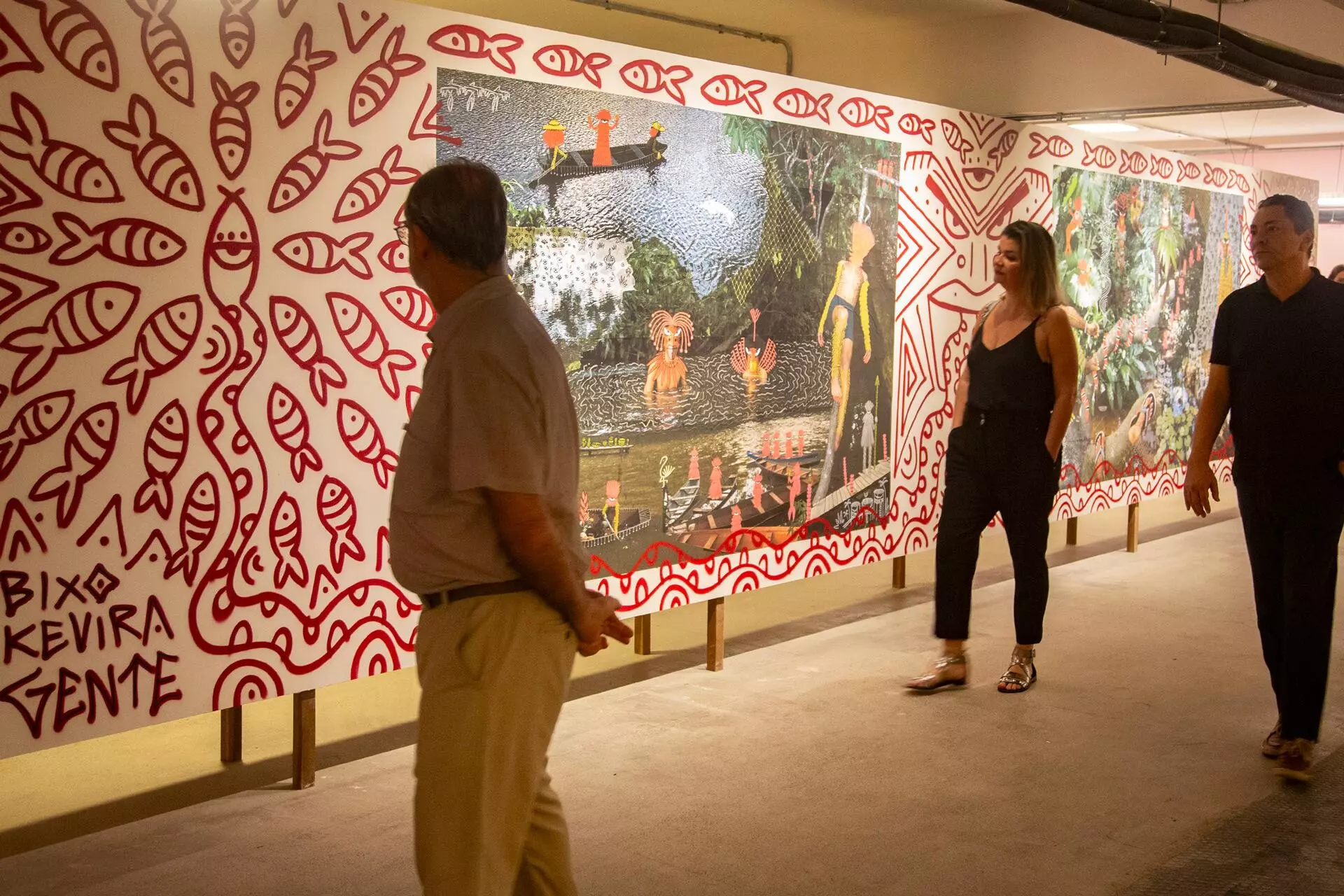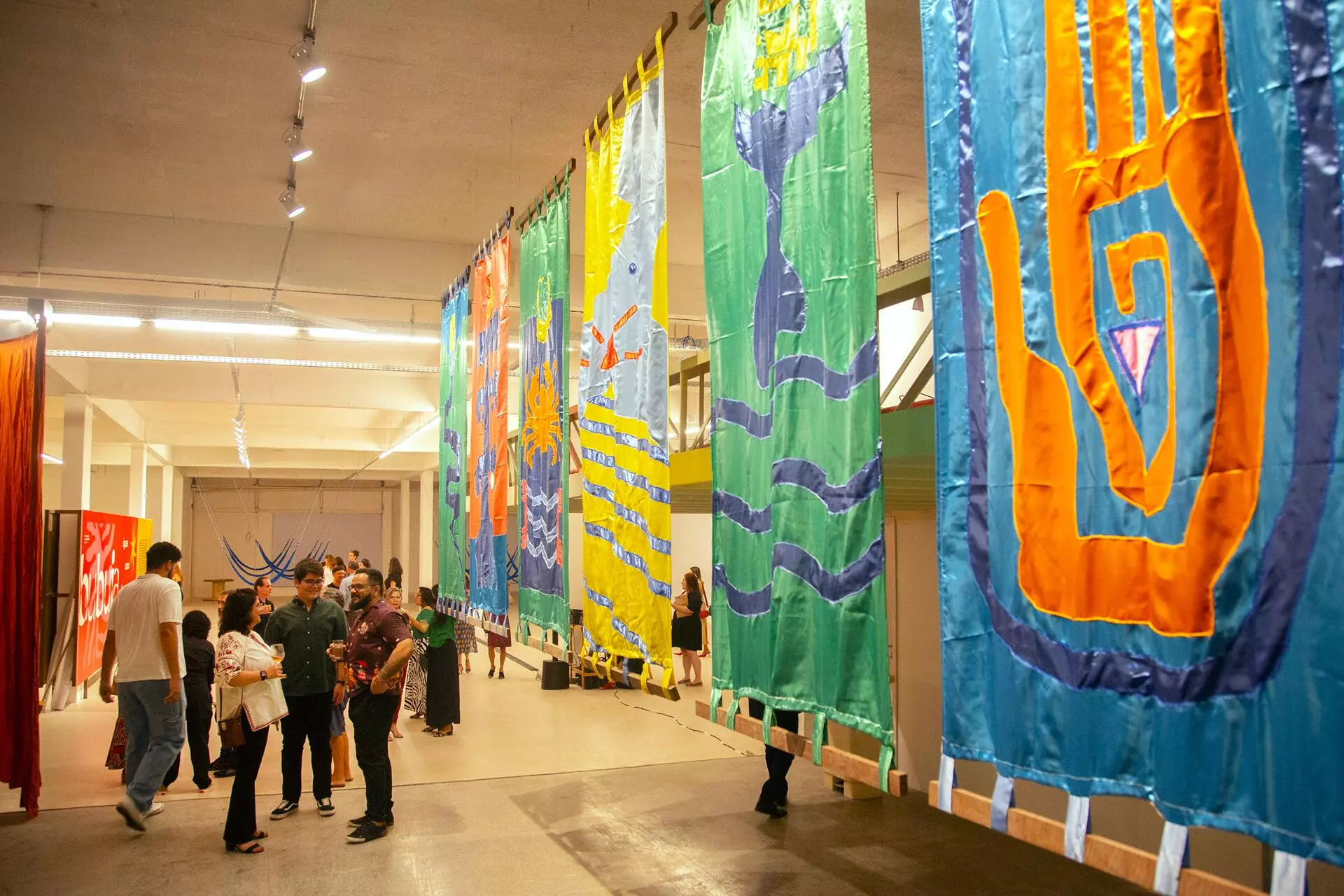The first Biennial of the Amazons immediately makes the plurality of the exhibit explicit in its name. With works from 121 artists and collectives from the nine territories who share the biome, the event tried to represent the distinct realities of a multiple people. A long process, carefully executed by a group of women just as diverse as the Amazon.
Sandra Benites, a member of the Guarani Nhandeva people, was one of the four curators responsible for selecting works and participants for the show, open until November 5, in Belém. “Art is a bridge of dialog to show not just what is good or important, but also to make some provocations about what bothers us,” she says.
Born in the Porto Lindo Indigenous Territory, in the municipality of Japorã, in Mato Grosso do Sul, Sandra is an anthropologist, art curator, educator, and mother. Her story, like that of all of Brazil’s Indigenous people, was written in struggle and resistance. In late 2019, she became the first Indigenous woman to join the curation team at the São Paulo Art Museum (MASP). Nevertheless, in May 2022 Sandra exited through the same door she entered, after what she saw as censorship of photographs of the Landless Workers’ Movement (MST) in a show entitled Brazilian Histories.
Sandra had to take a leave of absence from the Biennial of the Amazons in April 2023, when she took over as the director of visual arts at Brazil’s National Arts Foundation (Funarte). Preparations for the show began back in 2019, but it only opened to the public in August 2023. Initial meetings were held when Sandra and other women were invited by the Biennial’s director, Lívia Condurú, to join the curation team. The theme, “Buoyancy: water as a source of imaginations and desires,” encapsulates something that is seemingly inert, but that floats to stay alive, strategically calm, because it knows how to deal with adversities and because it is looking to survive.
Here are edited extracts from SUMAÚMA’s conversation with the woman who tried, along with Vânia Leal, Flavya Mutran, and Keyna Eleison (the other three curators of the Biennial of the Amazons), to tell stories of peoples who are deep within and are entwined so that the world’s largest rainforest continues to exist.
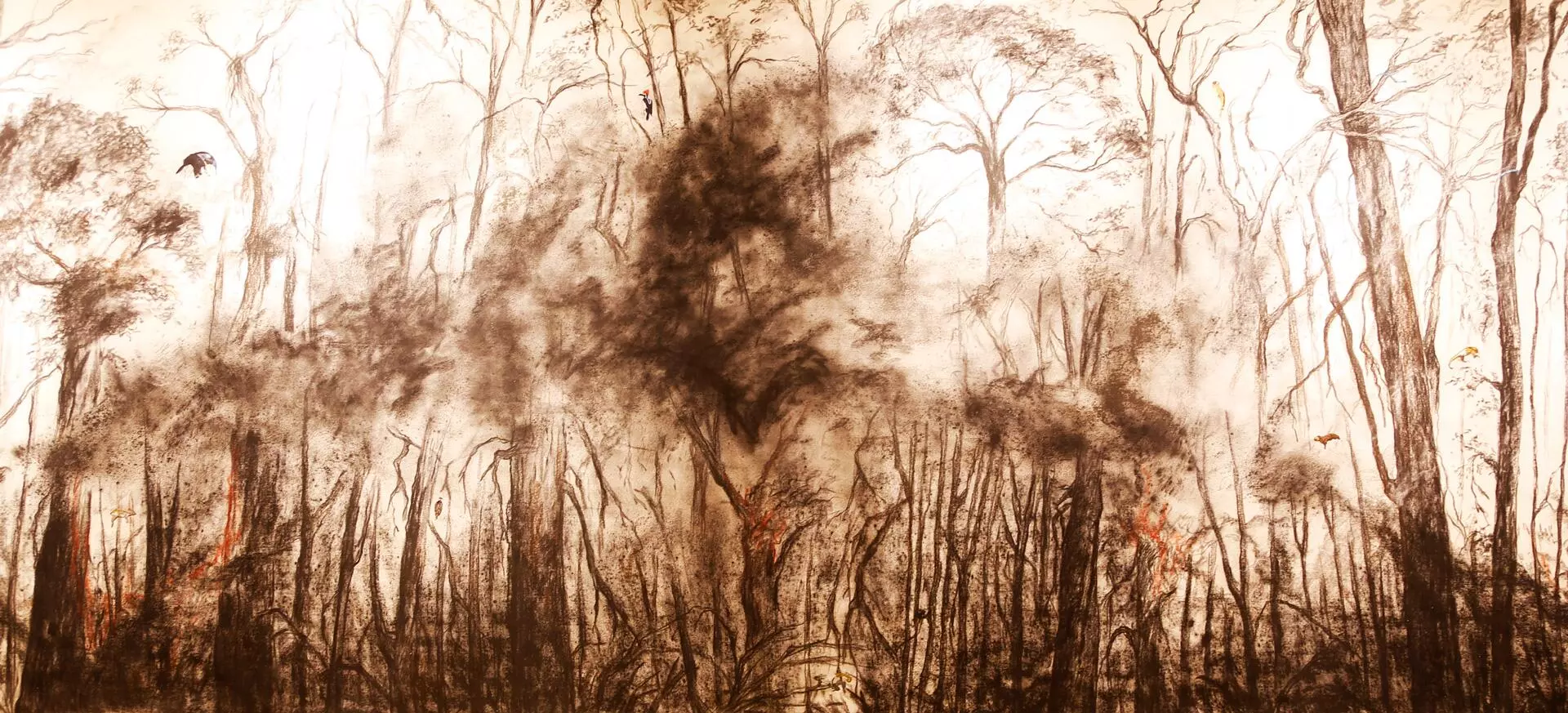
El Bosque em Llamas, a work by Nohemí Pérez, on display at the Biennial of the Amazons. Photo: Nailana Thiely
SUMAÚMA: What was the process of building the Biennial of the Amazons?
SANDRA BENITES: It was a long road. I learned a lot. They are all very competent and dedicated women. I was invited by Lívia [Condurú] by e-mail. She explained what the Biennial would be like and that it was a dream of hers. She shared that she was inviting four women to be part of the group of curators: Vânia Leal, Flavya Mutran, Keyna Eleison, and me. I was very excited and happy. We formed a team and we went along holding meetings, get-togethers, talks. We began to organize, to align ourselves in the work and think together.
One interesting thing was thinking about the reality of the Amazons, especially around the idea of the fetish that the Amazon represents. And we, women, regardless of where we come from, are part of this fetish. We are left invisible. No matter how much hard work you do, how many more things, you are never recognized simply because you are a woman. So when we got together, debates always considered the issue of bodies and the Amazon. From there we thought of a concept.
What was this concept?
I offered my perception, as a Guarani, about the idea of sapukai [a Guarani word describing pleasure and love, pain and horror]. For us, the Guarani, sapukai is a shout, but it’s not just a shout. It’s a shout, it’s a chant, it can be weeping, it can also be a voice. It involves feeling and it has this complexity, not to mention it has a lot to do with the chanting of Guarani women, which is also sacred. The perception of sapukai and of the Amazon are connected. When we think of the Amazon beyond the fetish, we seek to deconstruct this romantification, because it is all of this: a shout, a chant, weeping, voice, sacredness.
Does this mean the sapukai is built collectively?
Our debates always raised the issue that there is an unseen simmering in the Amazons. Those who aren’t from the region generally just see a thick forest, beautiful, untouchable. Yet there are people living in this space.
In this sense, Vânia and Flávia brought another concept to the show, which is the idea of buoyancy, of the meeting of waters. I think this is quite a strong debate, because the Amazon, the Biennial of the Amazons, doesn’t just talk about the forest.
Of course we can’t deny the forest, but most of this movement that keeps the forest alive comes from people, people who are not seen. The Amazon’s culture is very strong, yet while everyone admires it, the people are made invisible.
What does this Biennial want to make visible?
The challenge posed is to offer the debate so that it can be more deeply seen, making it possible to set aside this exotic view of the Amazon, as just a forest, an untouchable thing. The Amazon is also what is beneath the trees. For us, the Guarani, in our language guy means below the plants; ka’a is plants; and ka’aguy means forest. So what is under the plants? The things living under the plants are us, people. People who survive, who work hard, who make the Amazon what it is. It isn’t as simple as looking at an açaí gatherer who arrives at the Açaí Market at four o’clock in the morning as an artist, though he is. This is a big question – at least for me: how can I put out this call for these people who are not recognized as artists? And that’s why a gap still remained, a gap that is discussed at these large climate events, like the Amazon Summit was and like the COP-30 will be. I wonder if these events discuss the importance of these people. In no way am I saying that we shouldn’t discuss the issue of the forest, of global warming, because this destruction is not caused by açaí gatherers: it is outsiders who are responsible. But these people live in these spaces, and they remain invisible.
Some of the anguish in what you are saying is perceptible. What else distresses you?
Lots of things, but the layer of silencing regarding women ceramists has really bothered me. Their work has traditionally been very interesting, and I remember we talked about this lack of appreciation for these works. What they do is seen as craftwork, and not as art. Now the question remains: why isn’t it a work of art?
Except there were many things that were out of our reach to offer up all of these concerns. Many more questions remained, as did lessons. Many people use the argument of saving the Amazon, but they don’t discuss it with those who actually preserve the Amazon day to day.
This Biennial is important, but I hope that it doesn’t stop with the first edition and that it can bring more people from this same region to participate, because they are safeguarding the forest and what is beneath it.
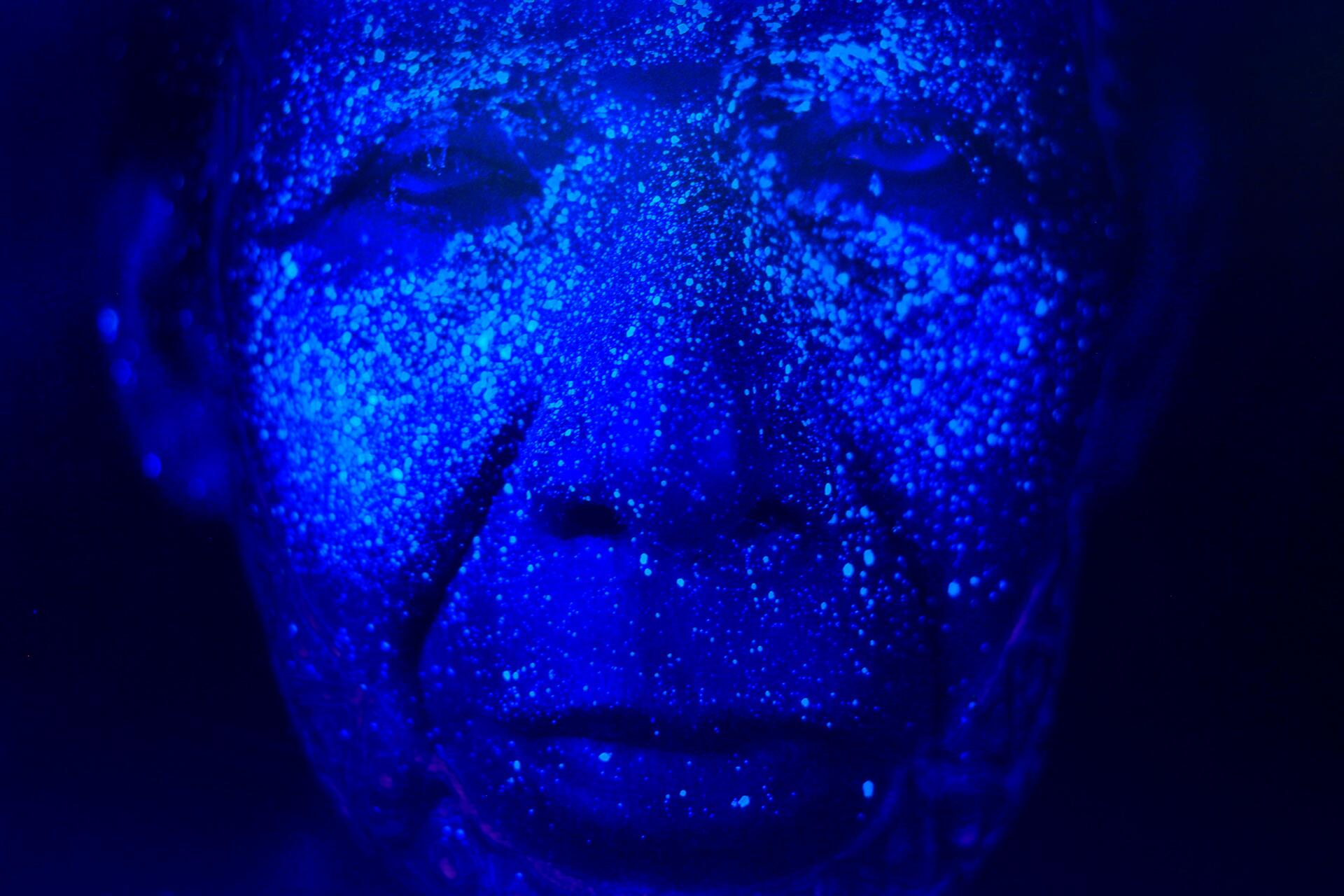
Indigenous photographer and filmmaker Paulo Desana is at the Biennial with a work from his series Pamürimasa (The Spirits of Transformation). Photo: Nailana Thiely
What was your time at the Art Museum of São Paulo, MASP, like?
It was confusing. I got the job for being an Indigenous woman, but when I arrived, I noticed that they only wanted an Indigenous woman as a number. I had no freedom to work, until this thing happened where they censored documents and photographs on the Landless Rural Workers Movement (MST) and photographs by artists João Zinclar, André Vilaron, and Edgar Kanaykõ.
That was the catalyst. I was taught from a young age that we shouldn’t have to make an effort to fit in places. If we are making an effort, then we shouldn’t be there. I’m not Sandra, I’m a collective of women, of my people. Alone I couldn’t do anything at MASP, so I resigned. It was painful, agonizing, but necessary. I don’t regret it.
Is this inquietude something that you always bring to your curation?
Curating is a way to show my concerns. I offer this, like my silencing, to talk about what is bothering me. Art can’t and shouldn’t close itself up into itself.
Today we are talking about the issue of art. Is it important? Yes. But it doesn’t take care of everything. We say that art is a bridge of dialog to show not just what is good or important, but also to make some provocations about what bothers us.
This type of movement is still very hard to see, even in the non-Indigenous art world. It is very hard to break this in the western view, because there are things that are simply not understood as art. Like the art of gathering and processing açai, for instance.
Is the wisdom of the forest peoples art?
Yes, and I’ll tell you a story. I was once given a muiraquitã [a frog-shaped amulet to bring luck and happiness, as well as to protect against disease – it cannot be purchased and must be received as a gift] and I looked into the history of the necklace. I discovered that it’s the women who have this narrative of making the object, which is seen as a legend or folklore. When we tell a story like the story of the muiraquitã, it is a way for you to protect a space. In the western view, this is not seen as something important, but this is science too: knowing how to protect, knowing how to manage, knowing how to build. You will not destroy the environment if you understand it as sacred. This is wisdom, this is art.
We also have many stories that nobody hears, but when some outsider shows up to say they will save the Amazon, everyone listens. How will someone save the Amazon without listening to the people, the society living there, without knowing who the people living under the trees are?
This show is a provocation, a provocation of the need to go deeper and value the people who are the reason for the Amazon’s existence.
Fact-checker: Plínio Lopes
Proofreader (Portuguese): Valquíria Della Pozza
Spanish translation: Julieta Sueldo Boedo
English translation: Sarah J. Johnson
Photo Editor: Lela Beltrão
Layout and finishing: Érica Saboya
Editors: Malu Delgado (news and content), Viviane Zandonadi (editorial workflow and copy editing), and Talita Bedinelli (coordination)
Director: Eliane Brum
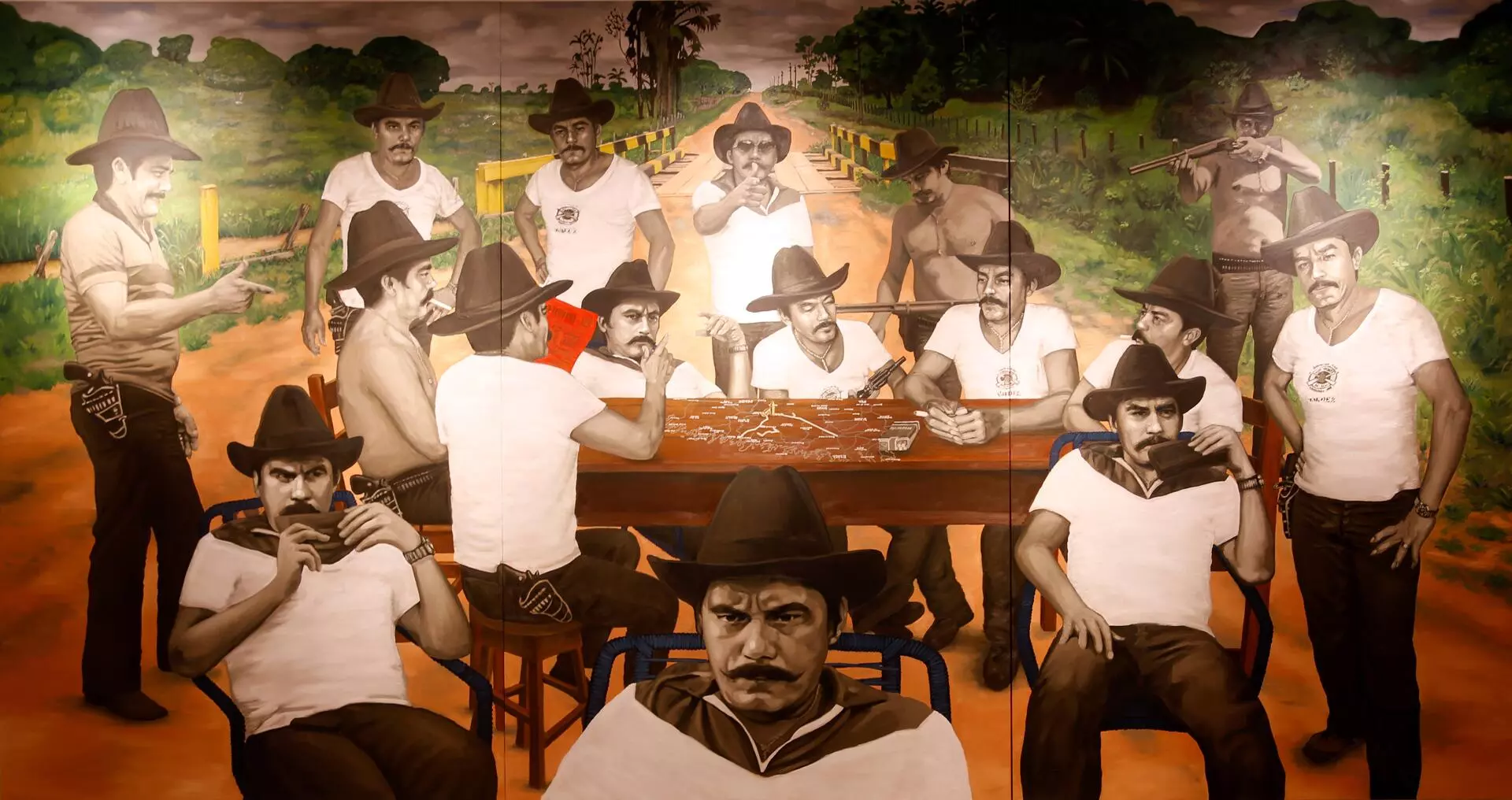
Quintino, by Éder Oliveira, an artist from Pará, was on display at the Biennial of the Amazons. Photo: Nailana Thiely




